MSI Katana GF76 review
MSI Katana GF76: Specs
CPU: Intel Core i7-11800H
GPU: Nvidia GeForce RTX 3060
Display: 17 inches, 1080p, 144 Hz
RAM: 16 GB
Storage: 1 TB SSD
Dimensions: 15.6 x 10.5 x 1.0 inches
Weight: 5.1 pounds
On paper, the MSI Katana GF76 gets everything right. This $1,500 machine features an 11th-gen Intel Core i7 processor, an Nvidia GeForce RTX 3060 GPU, and plenty of RAM and storage. With those components, it should be able to deliver spectacular gameplay and productivity performance. In reality, however, it’s just pretty good — most of the time.
The Katana GF76 is nothing special to look at, and it boasts the standard array of gaming laptop annoyances — bulky frame, high heat, lackluster sound and so forth. On top of those, however, it often staggers during day-to-day tasks, and arguably doesn’t have as many ports as it needs.
On the other hand, the Katana GF76 is not without its charms. Considering its screen size and components, it’s easily one of the cheapest gaming laptops you’ll get from a major manufacturer at this power level. Furthermore, while it didn’t benchmark well, it ran games just fine, and offered a better keyboard than some of its competitors.
While I can’t bring myself to recommend the Katana GF76 enthusiastically, it mostly does what it sets out to do, and at a reasonable price. Read our full MSI Katana GF76 review for more information.
MSI Katana GF76 review: Price and availability
Tom’s Guide purchased the MSI Katana GF76 11UE at Micro Center for $1,500. This model comes equipped with an Intel Core i7-11800H CPU, an Nvidia GeForce RTX 3060 GPU, 16 GB RAM, 1 TB SSD storage, and a 1080p, 144 Hz screen.
There are also two other versions available: the MSI Katana GF76 11UD and the MSI Katana GF76 11UC. The 11UD features an Nvidia GeForce RTX 3050 Ti GPU; the 11UC features an Nvidia GeForce RTX 3050 GPU. Otherwise, the specs are identical to the 11UE.
Interestingly, the Katana GF76 11UE doesn’t appear to be widely available; we had trouble finding 11UD or the 11UC for sale at all. We contacted MSI, and the company told us that you can find the 11UD at Walmart for $999; the 11UC doesn’t appear to be available anywhere right now. Micro Center also carries other 11UE variants.
MSI Katana GF76 review: Design
If you were to draw a mental picture for “gaming laptop,” sight unseen, you would probably come up with something very similar to the MSI Katana GF76. It has a black plastic chassis, with a slightly metallic sheen and a few angular flourishes toward the front and back.
There’s an MSI logo on the lid, and a keyboard that lights up in red. It’s not pretty, and there’s some wasted space on the inside, particularly the large border around the keyboard and the noticeable bezels near the screen. But it gets the job done — particularly the large and numerous hexagonal vents on the bottom.
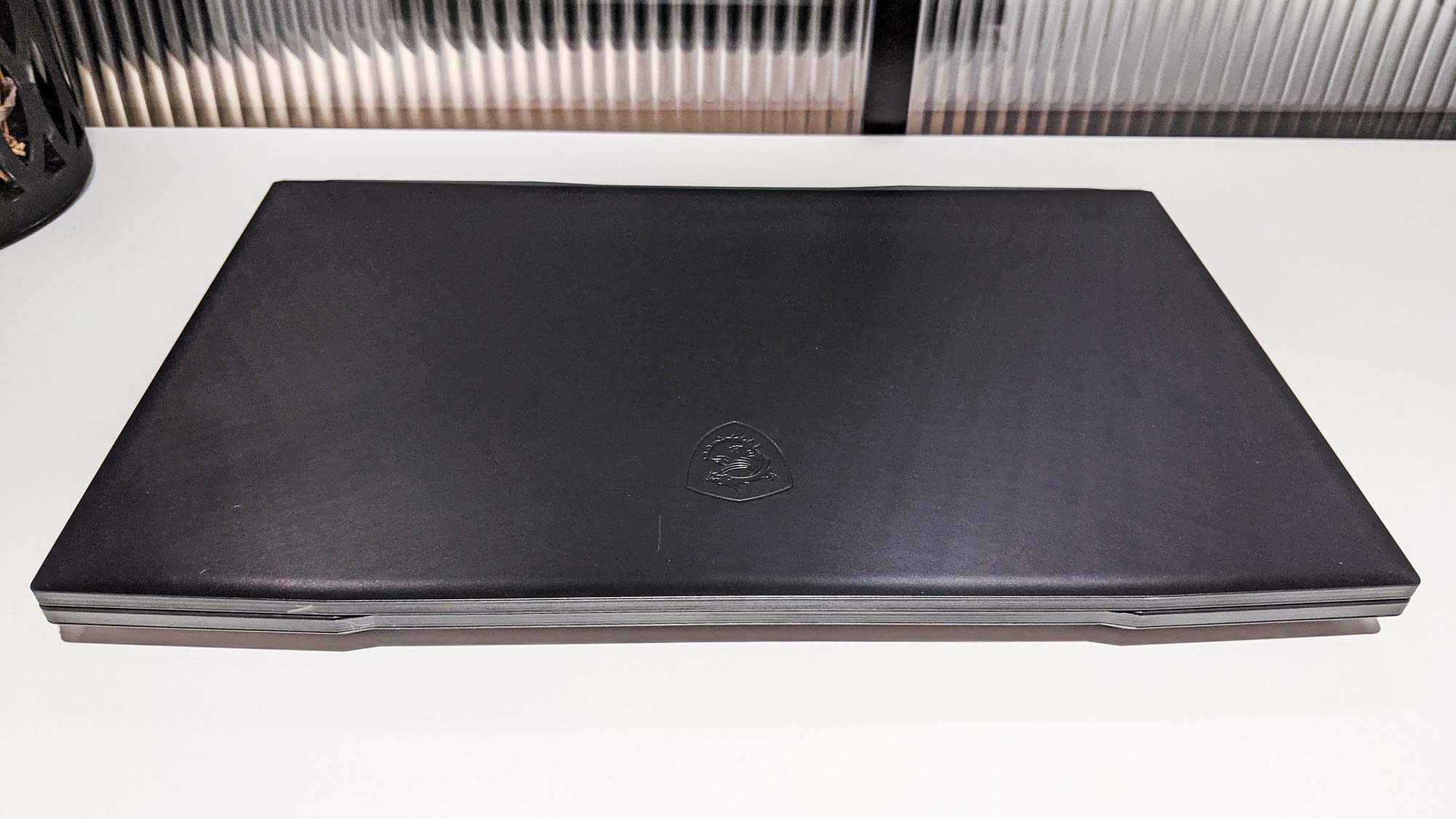
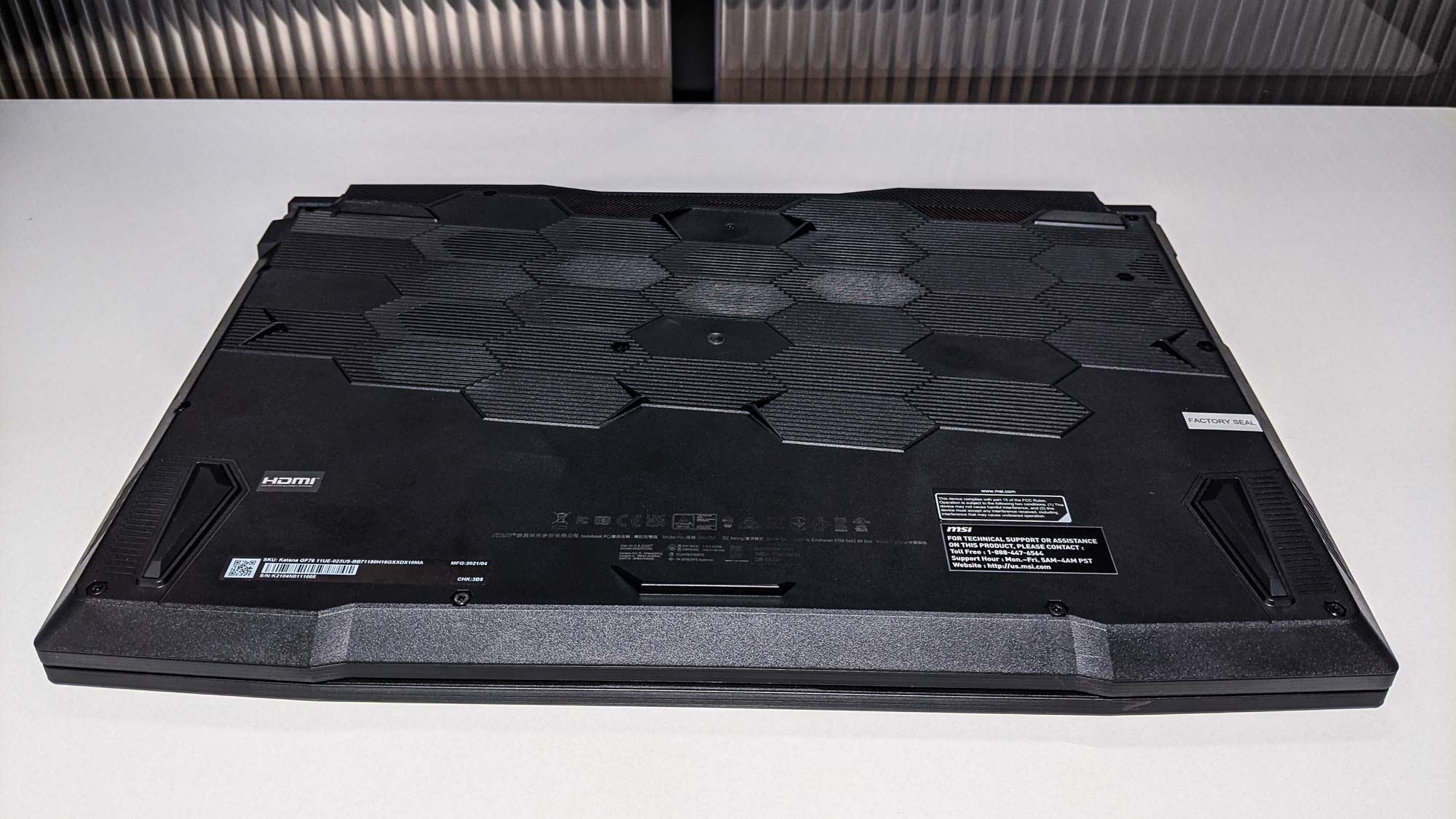
Be warned, though, that if you want the GF76’s 17-inch screen, you’ll have to deal with a pretty large, heavy laptop as a result. The machine measures 15.6 x 10.5 x 1.0 inches, and weighs 5.1 pounds. It fit in my backpack without too much trouble, but I can only imagine how I’d feel after carrying it around a convention center or airport all day.
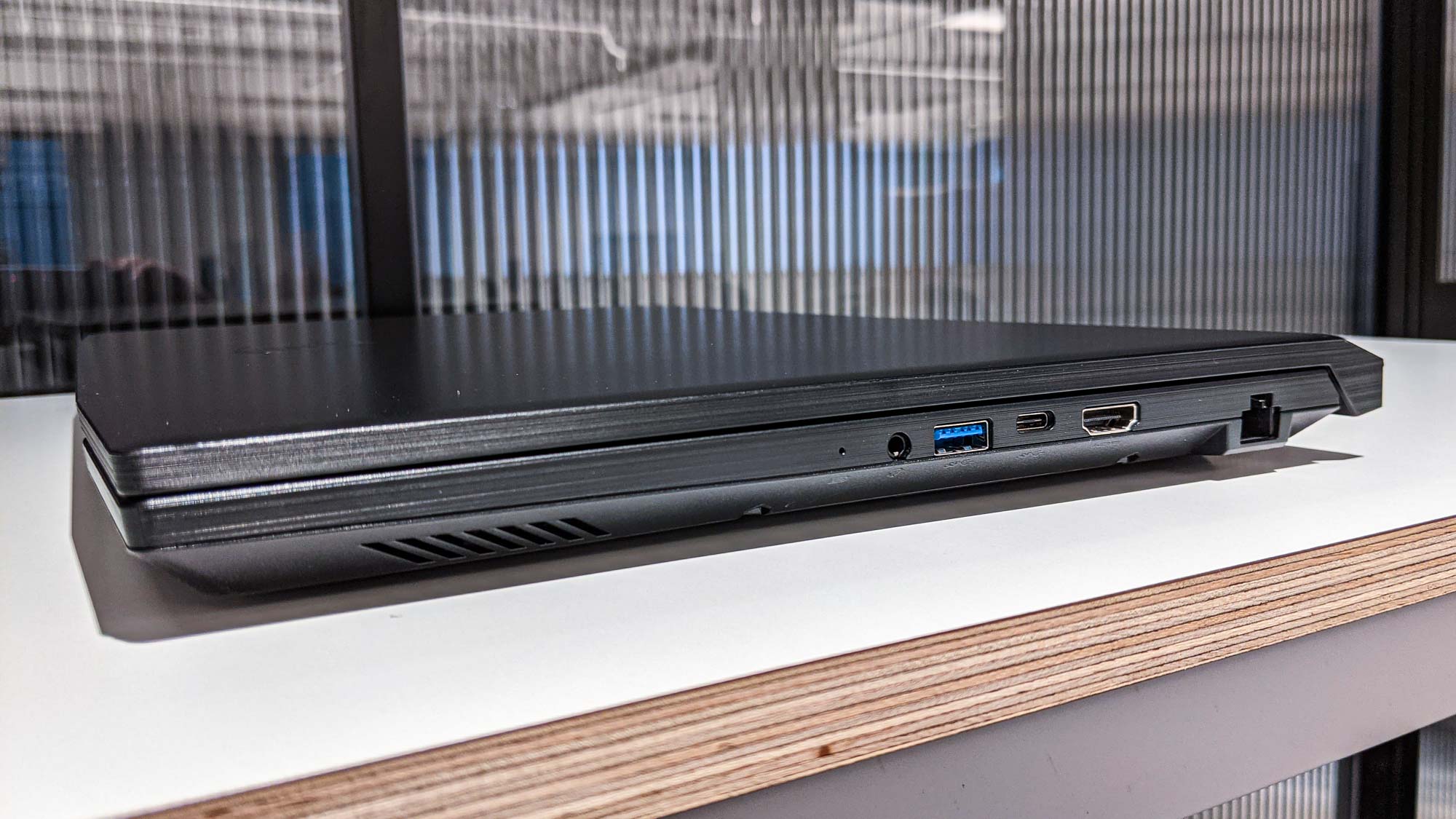
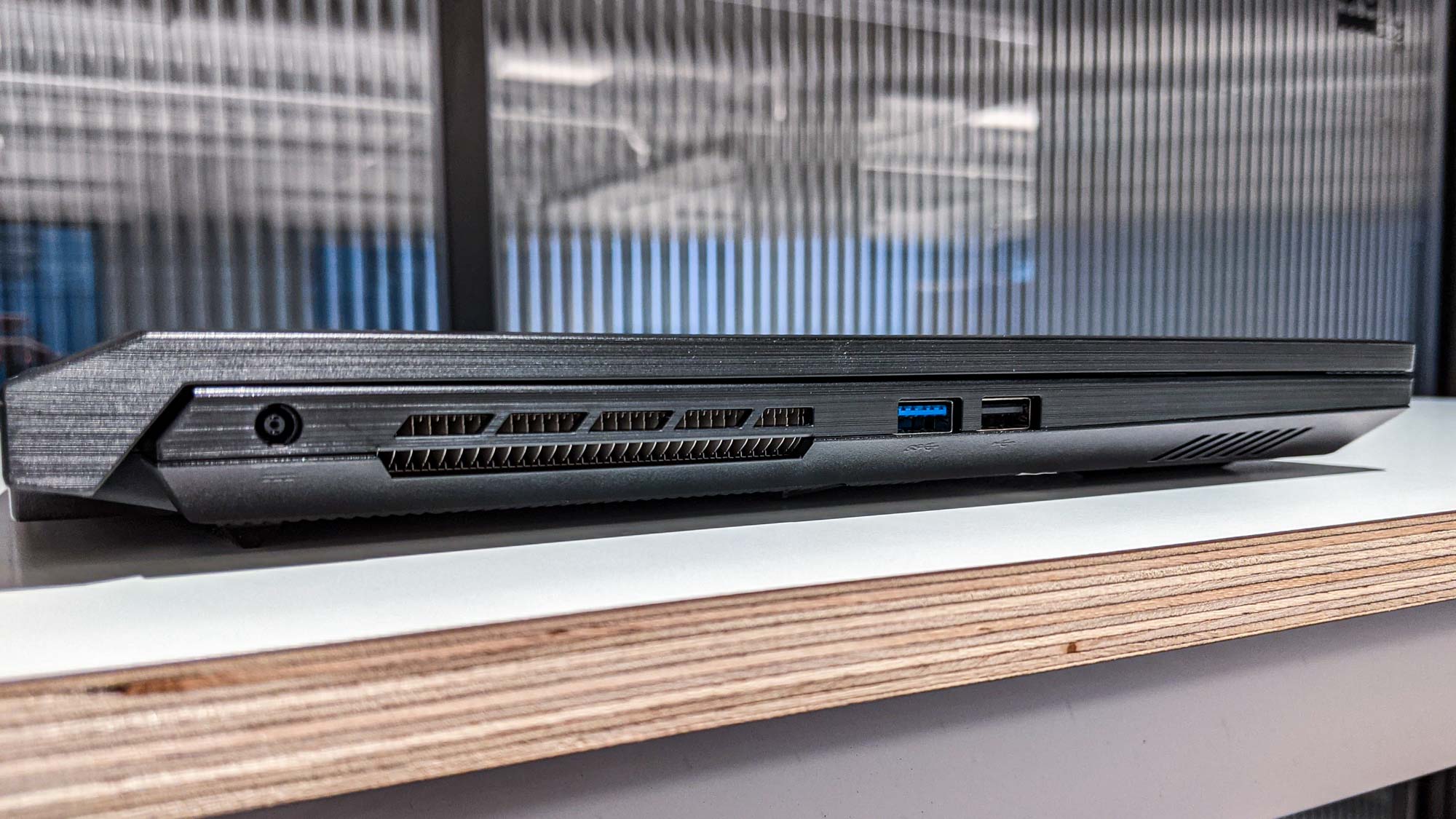
The system also doesn’t have much in the way of ports. On the left side, there are two USB-A ports and a power port. On the right side, there’s an Ethernet port, an HDMI port, a USB-A port, a USB-C port and a 3.5 mm audio jack. Three USB-A ports is admittedly not too bad for a laptop, but only one USB-C port feels a bit limiting, particularly if you’re going to use it to plug into a monitor. A microSD port would have been handy, too.
MSI Katana GF76 review: Keyboard and touchpad
While I don’t think the MSI Katana GF76 has a superlative keyboard, I do have a tremendous soft spot for it. That’s because the GF76 has a complete number pad, as well as full-size Backspace, Delete, Enter and arrow keys.
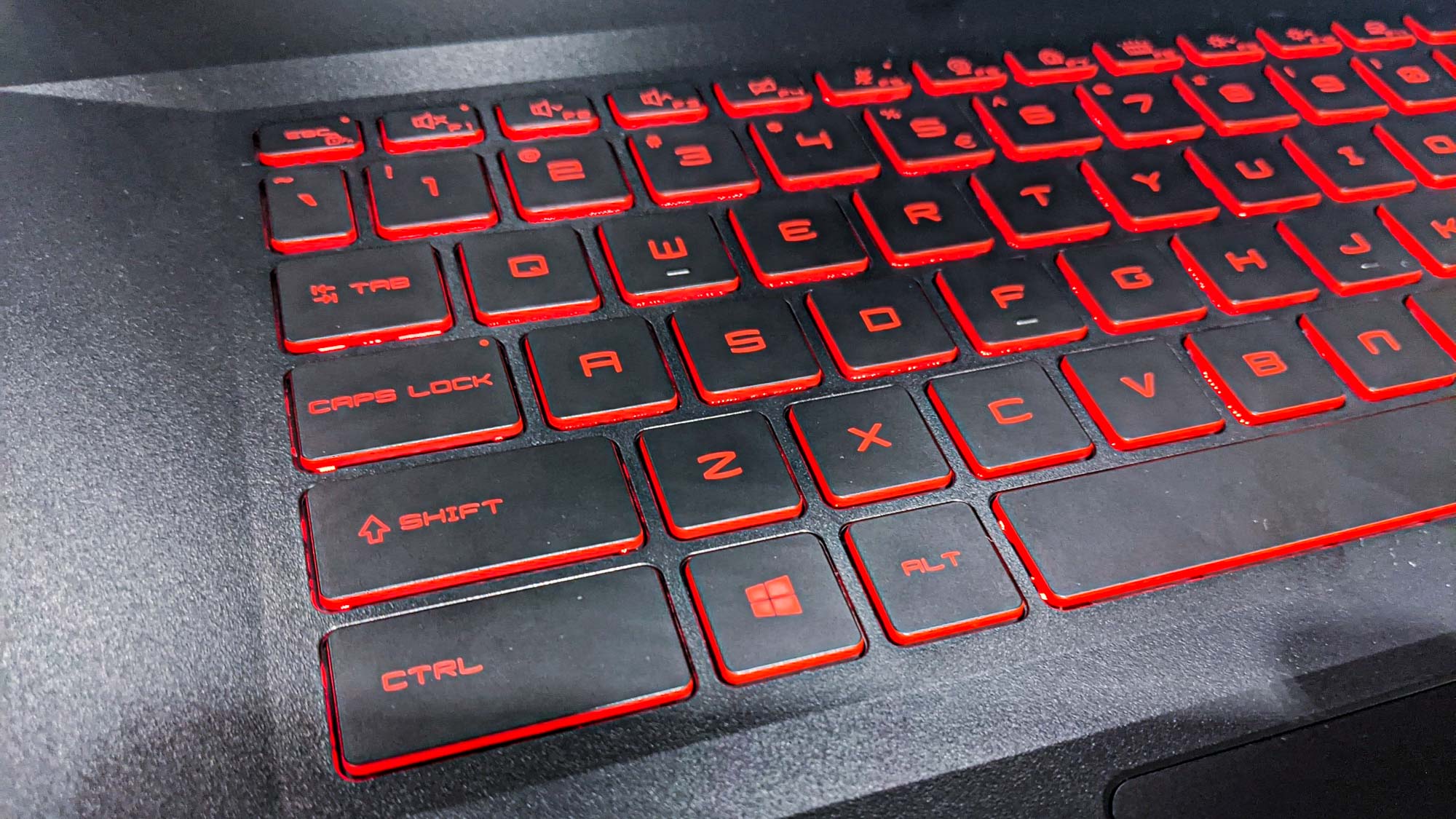
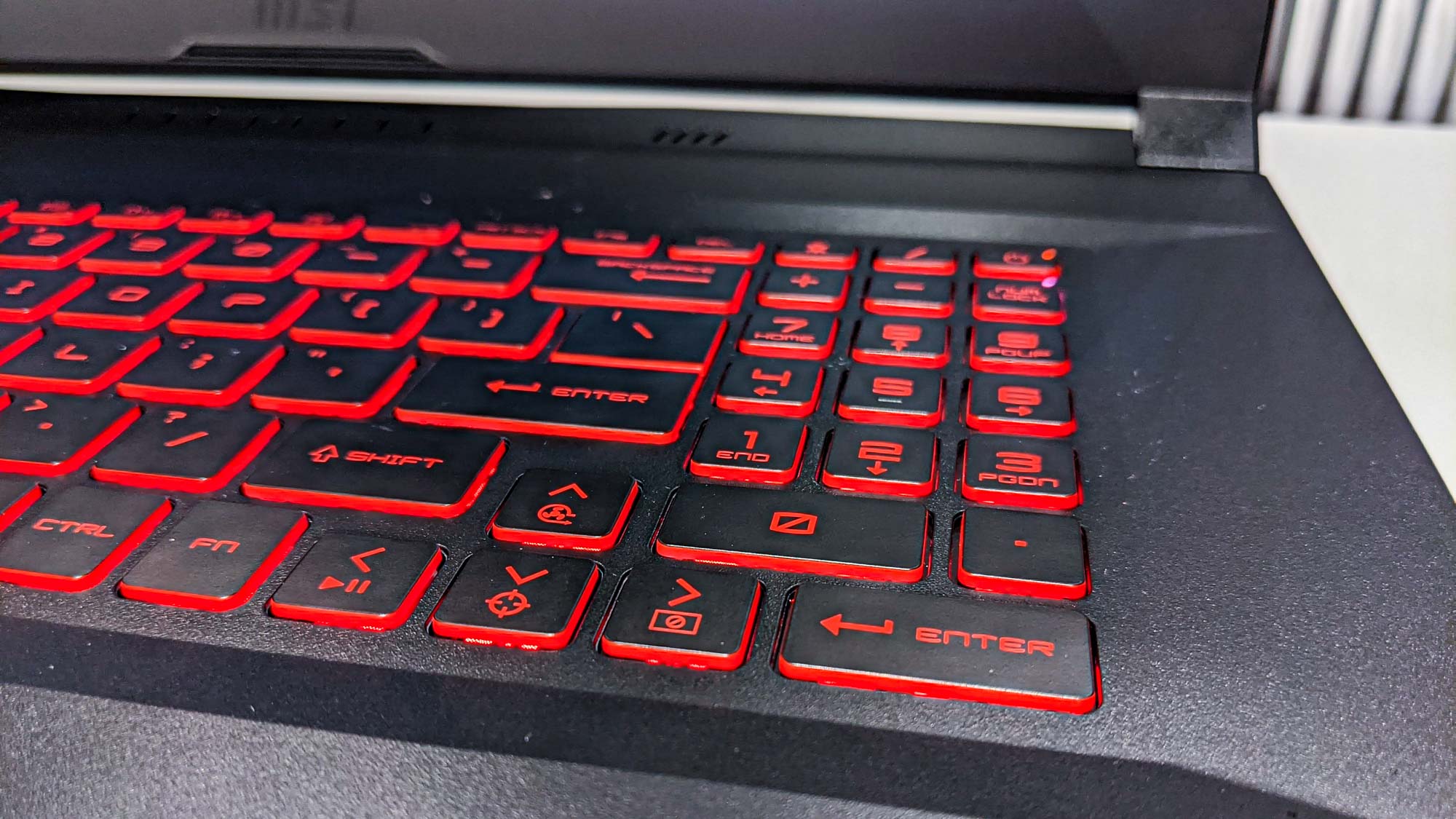
As a touch typist who hates how many compromises laptop keyboards usually make, the GF76’s keyboard design deserves some credit. Yes, the key travel is shallow; yes, some of the key placement feels cramped. But it has every key I wanted, and that’s worth something.
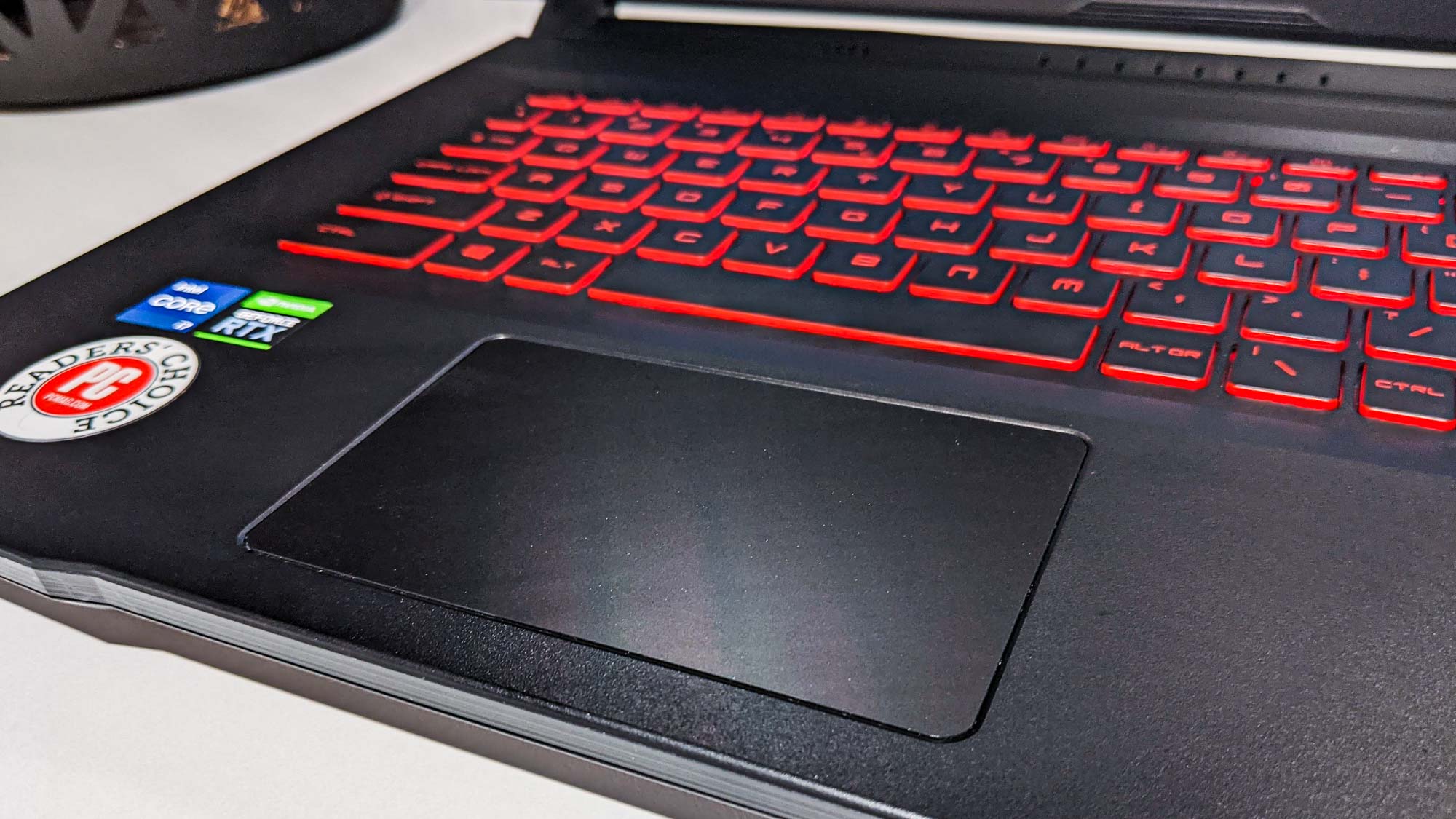
The touchpad is inoffensive, which is high praise as gaming laptops go. It’s slightly off-center, which means I didn’t accidentally rest my palms on it while trying to type. My commands registered quickly and accurately. Still, I hooked up a gaming mouse as soon as I got the computer up and running, and I imagine most prospective GF76 buyers would do the same.
MSI Katana GF76 review: Display and audio
One thing you should know about the MSI Katana GF76 is that its screen maxes out at 1080p. If you want portable QHD or 4K gaming, you’ll have to look elsewhere. However, the screen supports a generous 144 Hz refresh rate, and it has the capacity to push many games up that high. With a 17-inch screen, you may not even need a separate monitor, depending on how big your gaming space is.
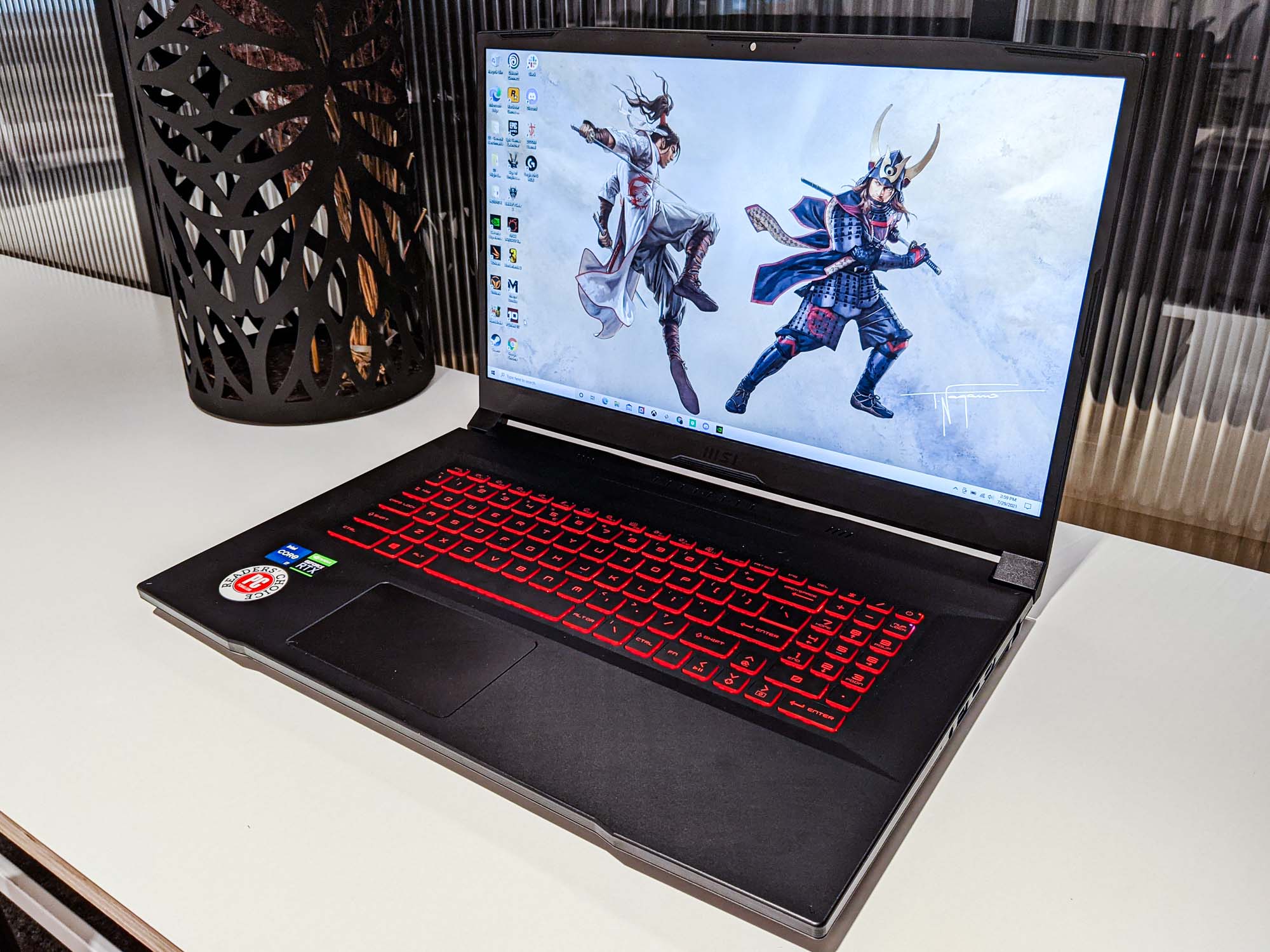
In terms of metrics, the Katana GF76’s screen features 247 nits of brightness, compared to 244 on the Razer Blade 15 Advanced, or 361 on the Alienware m15 R4. I never had trouble discerning what was happening onscreen, whether the surrounding room was bright or dark.
On the other hand, the Katana GF76 does not have a very colorful screen, displaying only 62% of the sRGB color spectrum. The Blade 15 Advanced can handle 124%, and the m15 R4 can do a whopping 211%. The GF76’s color accuracy isn’t so bad, though, with a Delta-E of 0.28, compared to 0.23 on the Razer and 0.32 on the Alienware. (Closer to zero is better.)
Granted, the Katana GF76 is a much cheaper machine than the Razer and Alienware models compared here, but color range and accuracy are absolutely vital when it comes to gaming. Having that big, bright screen only goes so far when the colors on display fall short.
In terms of audio, the Katana GF76 has typical laptop speakers — which is to say, you’ll want to get a gaming headset. The bass and treble are muddy at comfortable volume levels, and the overall sound gets distorted when you turn it up. MSI compensates for this by offering a robust suite of Nahimic audio tools, which can emulate 3D sound and so forth. It’s better than nothing, but it doesn’t solve the central problem.
MSI Katana GF76 review: Performance
The MSI Katana GF76’s real-world performance isn’t bad. However, it didn’t perform all that impressively in our benchmarks. As such, you won’t be able to crank up the settings all the way on the latest and greatest games — and the system may not perform perfectly if you elect to hook it up to a higher-res monitor. Let’s start with a numerical comparison. We measured frames per second in the games listed below at 1080p and Ultra settings:
| MSI Katana GF76 | Razer Blade 15 Advanced | Alienware m15 R4 | |
| Assassin’s Creed Valhalla | 61 | 74 | 70 |
| Grand Theft Auto V | 84 | 107 | 108 |
| Red Dead Redemption 2 | 53 | 70 | 68 |
| Shadow of the Tomb Raider | 69 | 88 | 77 |
While it’s important to remember that the Katana GF76 is a much cheaper system than either the Blade 15 or the m15 R4, the difference in performance is still worth discussing. Assassin’s Creed Valhalla, Red Dead Redemption 2 and Shadow of the Tomb Raider all exceed the 1080p/60 fps threshold, at least. But Red Dead Redemption 2 doesn’t, at least without turning some of the settings down.
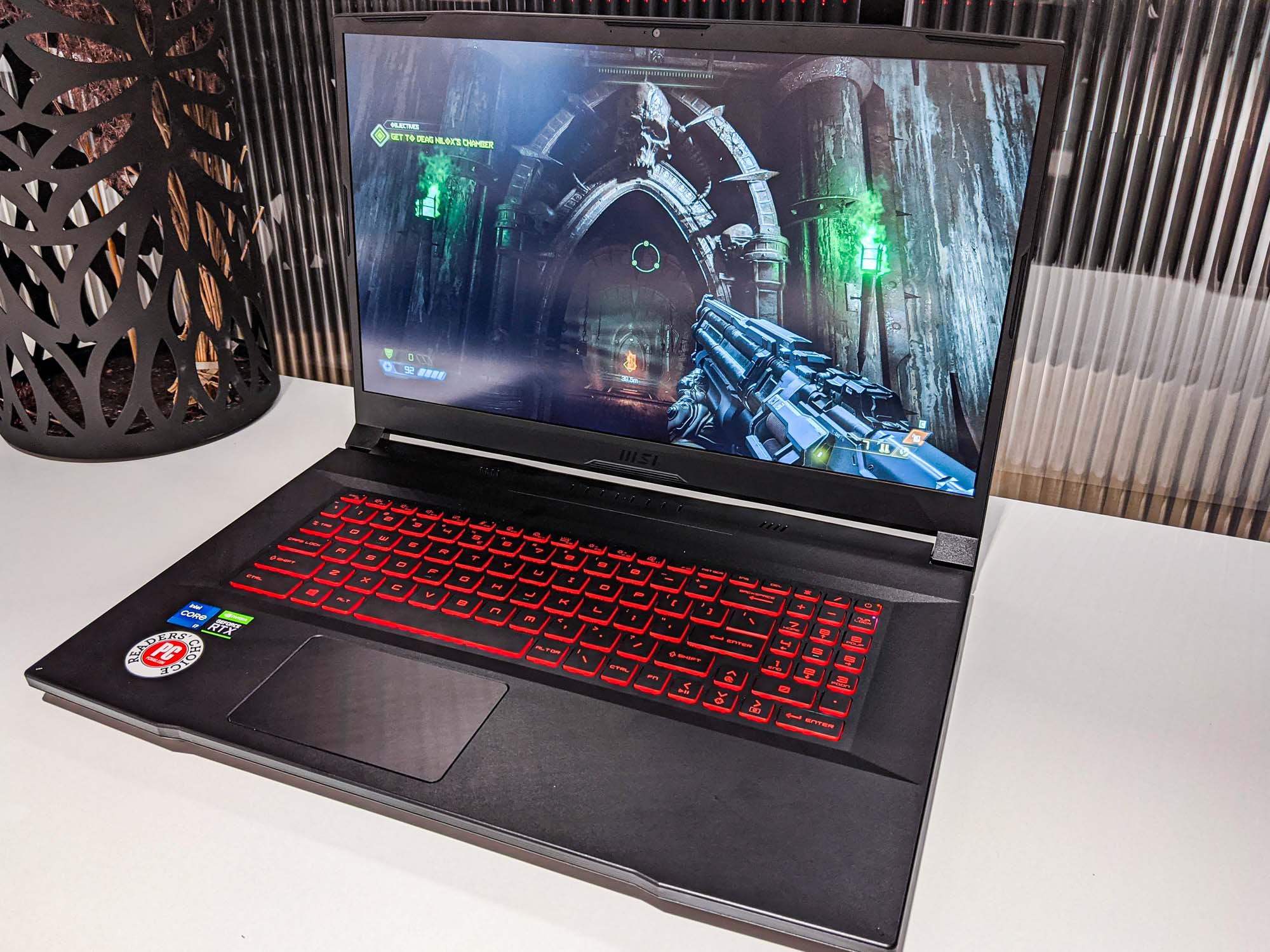
In fact, “turn down the settings” sums up my experience with the Katana GF76 pretty well overall. I tested the system with Age of Empires III: Definitive Edition, Doom Eternal, Baldur’s Gate III and Final Fantasy XIV. I managed to get good framerates and smooth performance out of every single game — but I also let the Nvidia GeForce Experience software choose the settings for me. They landed somewhere between “Medium” and “High” depending on the game. The Katana GF76 can’t play the latest games at maxed-out settings; then again, based on its specs, you probably wouldn’t expect it to.
Once I configured each game at a reasonable level, though, I was very pleased with the system’s performance. The 144 Hz screen turned out to be an especially useful tool for games like Doom Eternal and Final Fantasy XIV, both of which hovered in the 120-140 fps range, depending on whether I was exploring or fighting. Even the demanding Baldur’s Gate III rarely dropped below 90 fps.
In fact, I was generally pleased with the Katana GF76’s gaming performance. Its productivity performance, on the other hand, is where it ran into trouble. In spite of its powerful CPU and decent RAM allocation, the Katana GF76 doesn’t always run Windows or everyday apps all that well. The system frequently stuttered, and occasionally froze up, using the Nvidia GeForce Experience software. Microsoft Word lagged between my keystrokes and seeing my words onscreen; even Chrome would occasionally take ages to maximize from the taskbar.
We contacted MSI about these issues, and the company informed us that updating all relevant Windows, Nvidia and MSI drivers might help. We did so (even though the MSI Center software froze up when we tried at first), and performance has been a bit better overall since then. When hooked up to a monitor via HDMI, however, there’s still a bit of lag.
The Katana GF76’s productivity benchmarks were hit-or-miss. It transferred 25 GB worth of files from a thumb drive at a rate of 651 Mbps. That’s slower than the Blade 15 (890 Mbps) or the m15 R4 (1147 Mbps), but still pretty fast on its own merits. In fact, on the artificial Geekbench 5.4 benchmark, which measures a system’s overall power, the Katana GF76 beat out the Blade 15: 8,897 to 6,531. (There are no units.)
As far as I could tell, this isn’t an issue of resource distribution. Monitoring Task Manager, the computer rarely exceeded about one-quarter of its CPU power, or half of its memory.
Furthermore, the games described above — which are many magnitudes more demanding than productivity tools — never encountered any slowdown or setbacks.
MSI Katana GF76 review: Heat
Our lab tester, Madeline Ricchiuto, theorizes that the MSI Katana GF76’s productivity problems are due to its intense heat, and it’s a possibility. The Katana GF76 is positively searing when it’s firing on all cylinders: 128 degrees Fahrenheit while gaming, and 100 degrees Fahrenheit while on the desktop. That’s too hot to hold in your lap either way, and since hot systems don’t run as efficiently, it’s likely slowing down the whole operation.
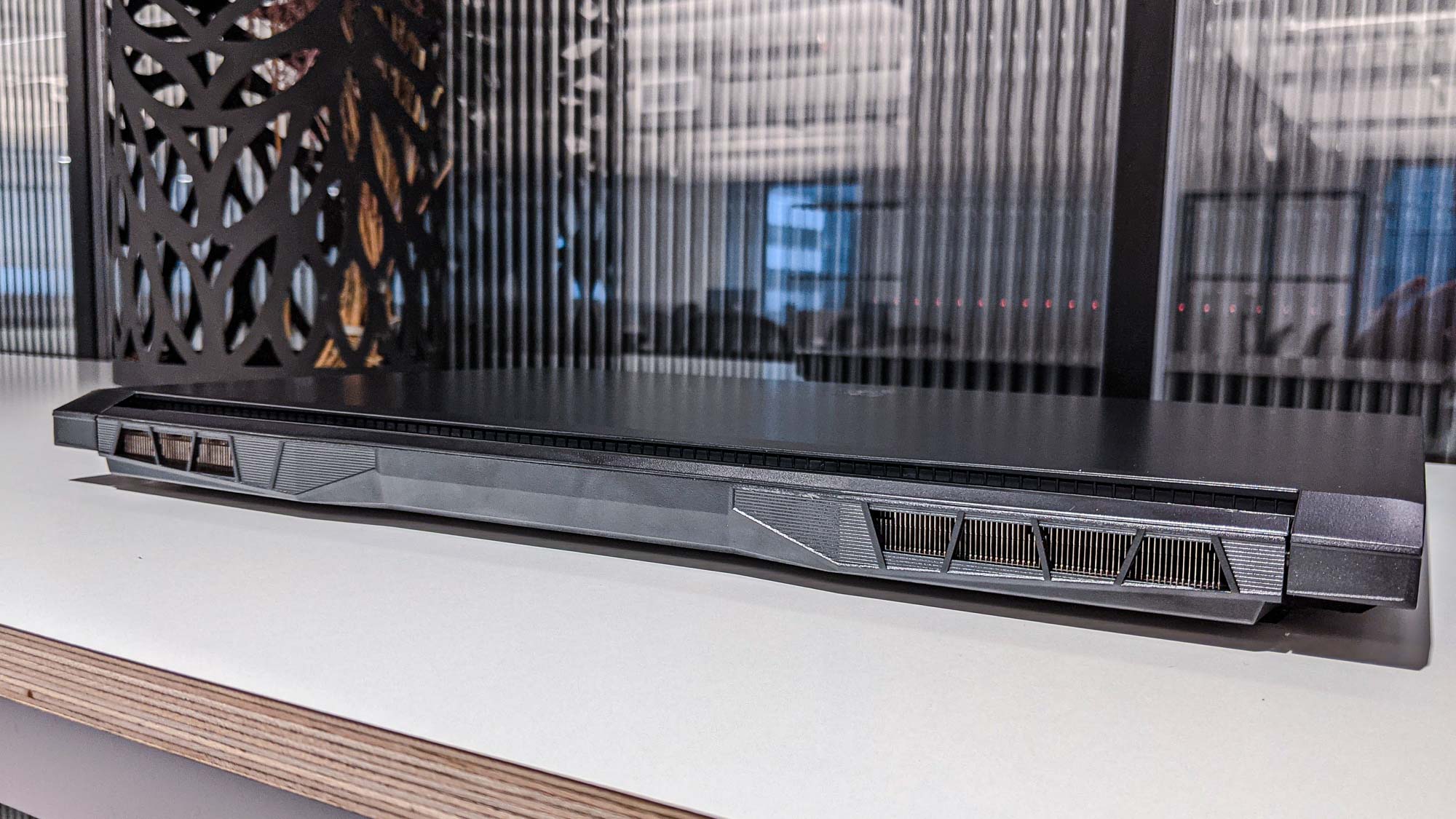
To compensate, you can use the built-in MSI software to adjust the fan performance, but your options are limited. You can keep the fan on a low setting, which does nothing to alleviate the heat. Or you can turn it up very high, which Madeline did not recommend:
“The fan on this thing when running in Extreme Performance mode is so freaking loud, you need ear protectors,” she wrote in our testing document. “When the computer was in this mode and idling, I could hear the fan three rooms away.”
MSI Katana GF76 review: Battery life
It’s just as well that you can’t use the MSI Katana GF76 in your lap, since you’ll need to keep it plugged in pretty much at all times. While gaming, the system gets only an hour of life; while not gaming, it can get up to two hours and 30 minutes. That’s long enough for short bursts away from a power outlet, but you’re not going to get any serious work, or play, done untethered.
MSI Katana GF76 review: Verdict
The MSI Katana GF76 has its charms, and its issues. It has powerful, modern components, and runs games very well at high settings. Above all else, that’s what a gaming laptop needs to do. However, its bulky design, inconsistent performance and extreme heat make it tough to recommend wholeheartedly.
I do think the Katana GF76 is worth a look for PC gamers who dream of acquiring a powerful laptop on a limited budget. But if you’re willing to make compromises on either the price or the components, something like the Blade 15 or the Acer Predator Triton 500 might work better.
For all the latest Technology News Click Here
For the latest news and updates, follow us on Google News.
